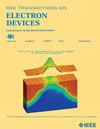Quasi-Periodic Sequences Generation of Ultrashort Pulses Based on the Superradiance of a Coaxial Cherenkov Generator Operating at Low Magnetic Field
IF 2.9
2区 工程技术
Q2 ENGINEERING, ELECTRICAL & ELECTRONIC
引用次数: 0
Abstract
A coaxial Cherenkov generator operating at a low magnetic field is proposed to generate ultrashort-pulse quasi-periodic sequences based on the effect of superradiance (SR). The device employs an extended slow wave structure (SWS) with combined variations in corrugation depth and period, resulting in enhanced spectral continuity and higher SR power. Most of the microwave power is coupled into the hollow waveguide formed by the inner conductor of the coaxial SWS. A portion of the SR pulse generated in the coaxial SWS is reflected back into the SWS, where it is primarily absorbed by disturbed electrons rather than seeding the next SR pulse. Particle-in-cell (PIC) simulations demonstrate that under a diode voltage of 720 kV, beam current of 19.2 kA, and guiding magnetic field of 0.54 T, six short pulses with instantaneous peak power of 15.5–28.5 GW and full width half maximum (FWHM) durations of 0.7–1.4 ns are produced within a 50 ns window. The inter-pulse intervals range from 4.4 to 8.8 ns. The frequency is in the X-band with an 800 MHz bandwidth at the −10 dB level. The variations in peak power and timing are thoroughly analyzed, and the physical mechanisms underlying the quasi-periodic ultrashort-pulse formation are elucidated. A new insight is provided that the critical factor for the sequence formation based on the SR effect lies in the recovery of the electron beam to an undisturbed state after each pulse.基于低磁场工作的同轴切伦科夫发生器超辐射产生超短脉冲的准周期序列
提出了一种工作在低磁场下的同轴切伦科夫发生器,利用超辐射效应产生超短脉冲准周期序列。该器件采用扩展慢波结构(SWS),结合波纹深度和周期变化,从而增强了频谱连续性和更高的SR功率。大部分的微波功率被耦合到同轴SWS的内导体形成的空心波导中。在同轴SWS中产生的SR脉冲的一部分被反射回SWS,在那里它主要被干扰电子吸收,而不是播撒下一个SR脉冲。粒子池(PIC)仿真结果表明,在二极管电压为720 kV、束流为19.2 kA、引导磁场为0.54 T的条件下,在50 ns窗口内可产生6个瞬时峰值功率为15.5 ~ 28.5 GW、全宽半最大值持续时间为0.7 ~ 1.4 ns的短脉冲。脉冲间隔从4.4秒到8.8秒不等。频率为x波段,带宽为800mhz,−10db。深入分析了峰值功率和时间的变化规律,阐明了准周期超短脉冲形成的物理机制。提出了基于SR效应的序列形成的关键因素在于每次脉冲后电子束恢复到未扰动状态。
本文章由计算机程序翻译,如有差异,请以英文原文为准。
求助全文
约1分钟内获得全文
求助全文
来源期刊

IEEE Transactions on Electron Devices
工程技术-工程:电子与电气
CiteScore
5.80
自引率
16.10%
发文量
937
审稿时长
3.8 months
期刊介绍:
IEEE Transactions on Electron Devices publishes original and significant contributions relating to the theory, modeling, design, performance and reliability of electron and ion integrated circuit devices and interconnects, involving insulators, metals, organic materials, micro-plasmas, semiconductors, quantum-effect structures, vacuum devices, and emerging materials with applications in bioelectronics, biomedical electronics, computation, communications, displays, microelectromechanics, imaging, micro-actuators, nanoelectronics, optoelectronics, photovoltaics, power ICs and micro-sensors. Tutorial and review papers on these subjects are also published and occasional special issues appear to present a collection of papers which treat particular areas in more depth and breadth.
 求助内容:
求助内容: 应助结果提醒方式:
应助结果提醒方式:


